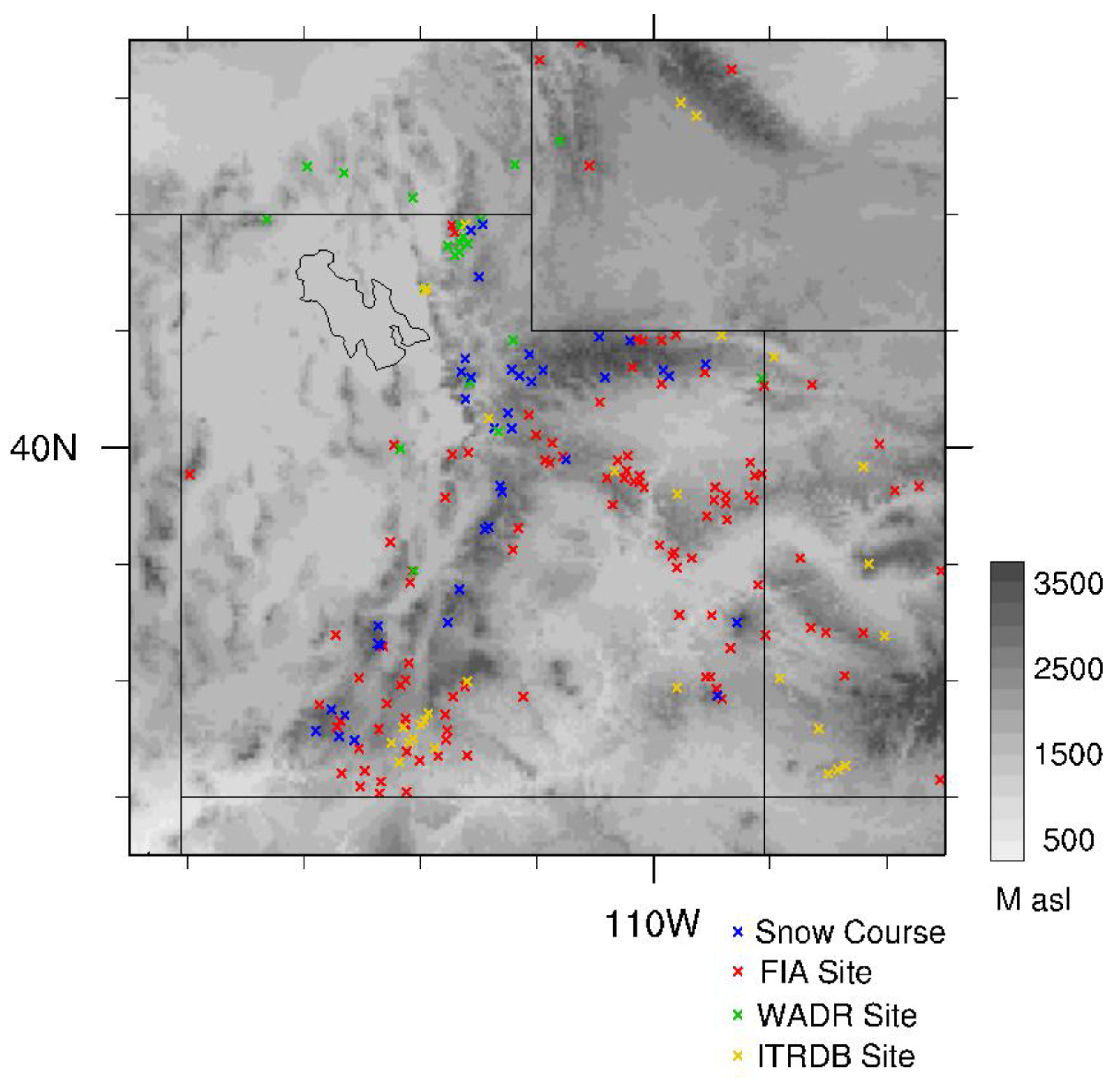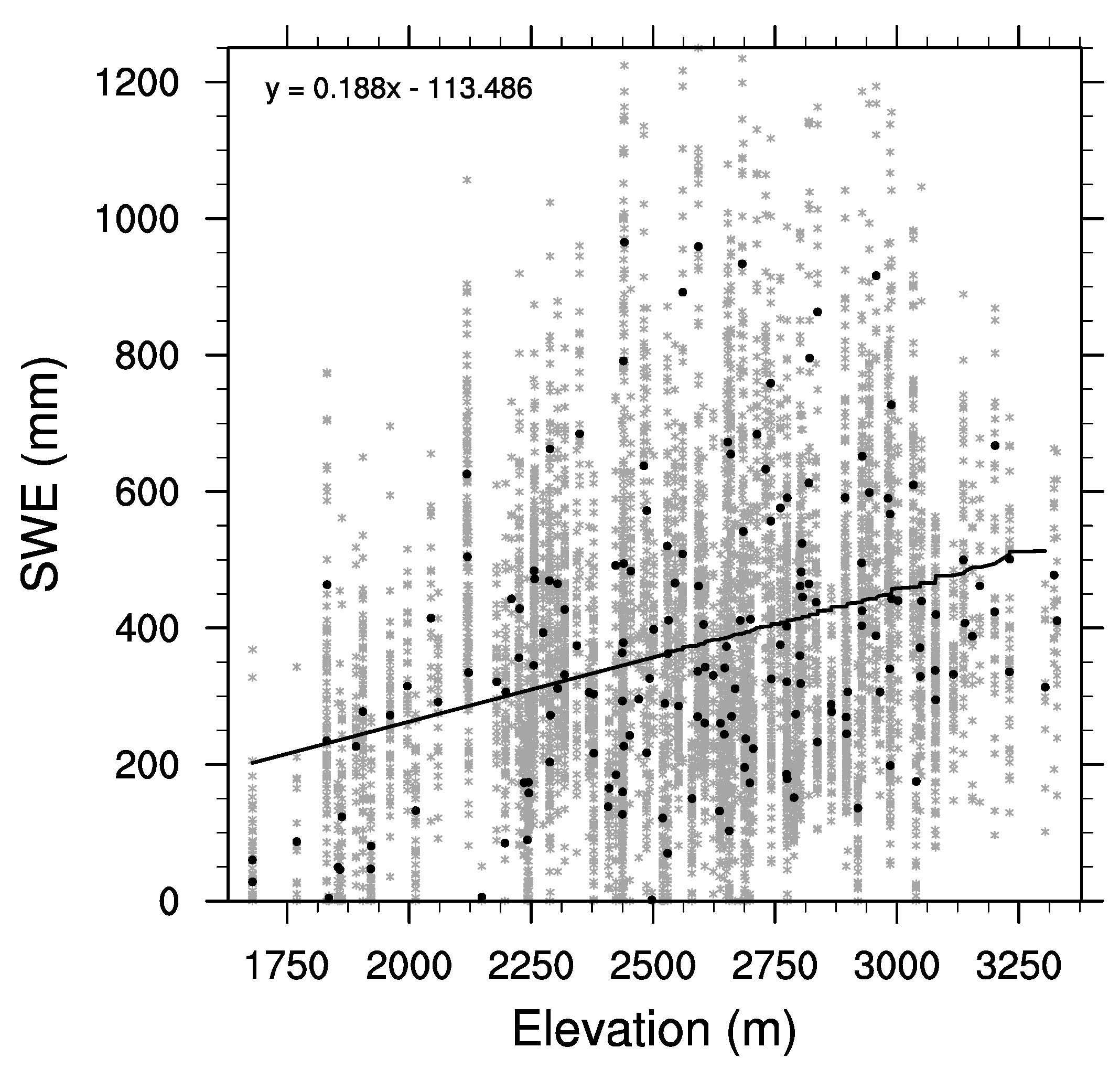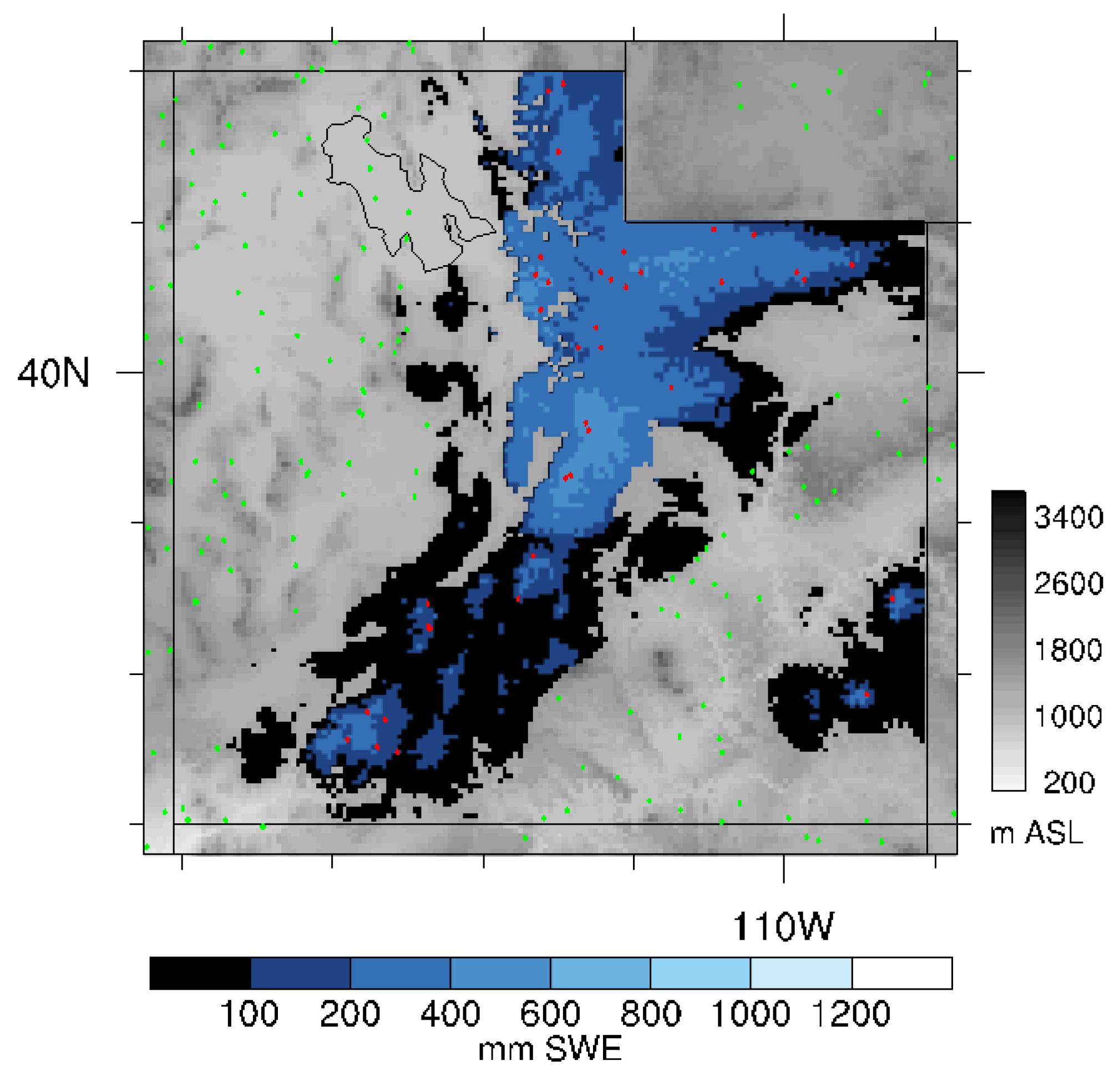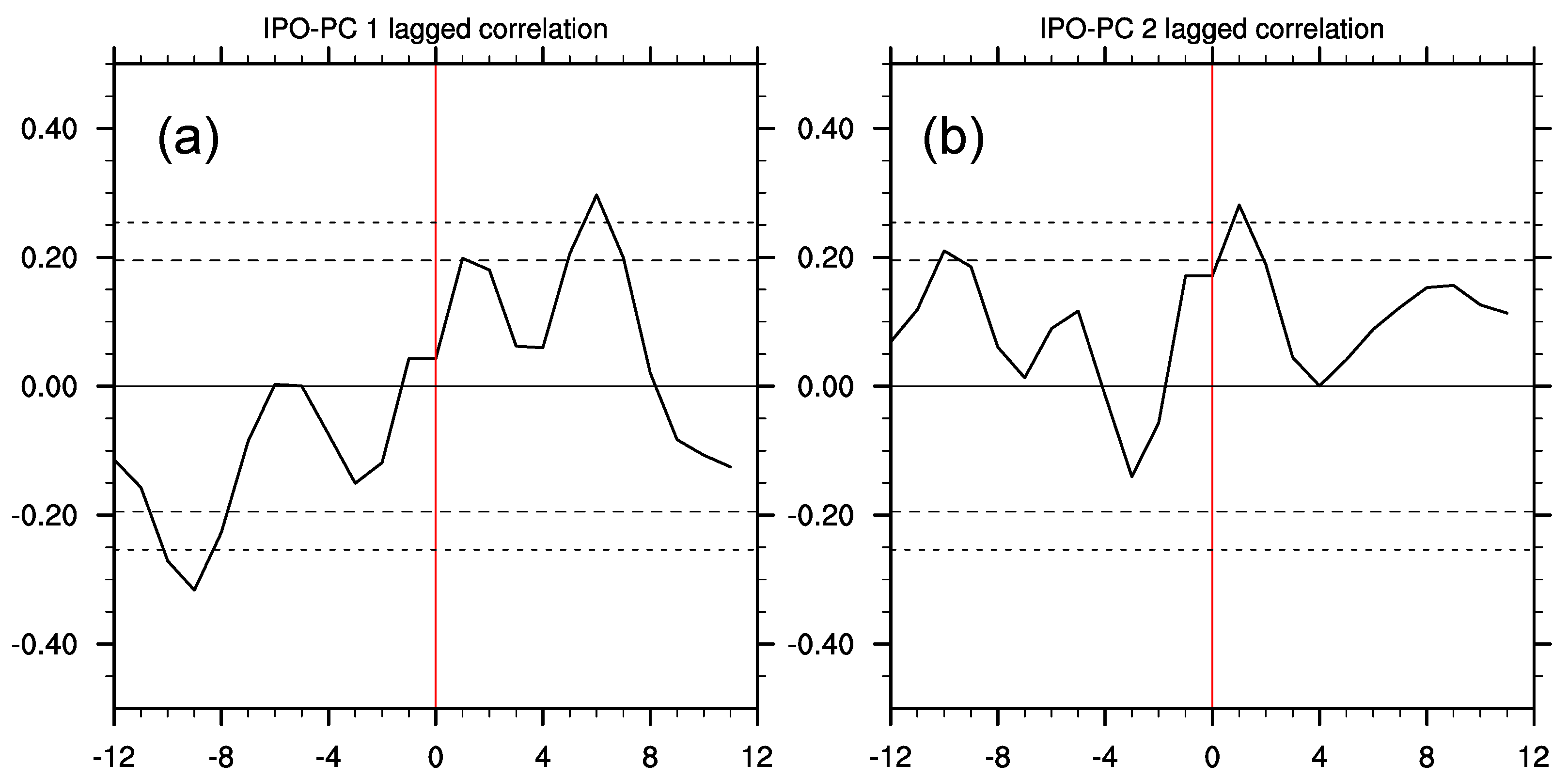Gridded Snow Water Equivalent Reconstruction for Utah Using Forest Inventory and Analysis Tree-Ring Data
Abstract
:1. Introduction
2. Materials and Methods
2.1. Observational and Climate Data
2.2. Tree-Ring Data
2.3. Reconstruction Method
2.4. Gridded Interpolation
2.5. Climate Diagnostics
3. Results
3.1. Calibration and Model Validation
3.2. EOF Analysis and Climate Diagnostics
4. Discussion
Comparison of Spatial Variability
5. Conclusions
Supplementary Materials
Acknowledgments
Author Contributions
Conflicts of Interest
References
- Nash, L.L.; Gleick, P.H. Sensitivity of streamflow in the Colorado Basin to climatic changes. J. Hydrol. 1991, 125, 221–241. [Google Scholar] [CrossRef]
- Barnett, T.P.; Adam, J.C.; Lettenmaier, D.P. Potential impacts of a warming climate on water availability in snow-dominated regions. Nature 2005, 438, 303–309. [Google Scholar] [CrossRef] [PubMed]
- Wise, E.K. Hydroclimatology of the US Intermountain West. Prog. Phys. Geogr. 2012, 36, 1–22. [Google Scholar] [CrossRef]
- Woodbury, M.; Balso, M.; Yates, D.; Kaatz, L. Joint Front Range Climate Change Vulnerability Study; Water Research Foundation Rep: Denver, CO, USA, 2012; 148p. [Google Scholar]
- Mote, P.W. Climate-Driven Variability and Trends in Mountain Snowpack in Western North America. J. Clim. 2006, 19, 6209–6220. [Google Scholar] [CrossRef]
- Gillies, R.R.; Wang, S.-Y.; Booth, M.R. Observational and synoptic analyses of the winter precipitation regime change over Utah. J. Clim. 2012, 25, 4679–4698. [Google Scholar] [CrossRef]
- Mock, C.J. Climatic controls and spatial variations of precipitation in the western United States. J. Clim. 1996, 9, 1111–1125. [Google Scholar] [CrossRef]
- Serreze, M.C.; Clark, M.P.; Armstrong, R.L.; McGinnis, D.A.; Pulwarty, R.S. Characteristics of the western United States snowpack from snowpack telemetry (SNOTEL) data. Water Resour. Res. 1999, 35, 2145–2160. [Google Scholar] [CrossRef]
- Stewart, T.S.; Cayan, D.R.; Dettinger, M.D. Changes toward Earlier Streamflow Timing across Western North America. J. Clim. 2005, 18, 1136–1155. [Google Scholar] [CrossRef]
- Clow, D.W. Changes in the timing of snowmelt and streamflow in Colorado: A response to recent warming. J. Clim. 2009, 23, 2293–2306. [Google Scholar] [CrossRef]
- Knight, T.A.; Meko, D.M.; Baisan, C.H. A bimillennial-length tree-ring reconstruction of precipitation for the Tavaputs Plateau, northeastern Utah. Quat. Res. 2010, 73, 107–117. [Google Scholar] [CrossRef]
- Gray, S.T.; Fastie, C.L.; Jackson, S.T.; Betancourt, J.L. Tree-ring-based reconstructions of precipitation in the Bighorn Basin, Wyoming, since 1260 A.D. J. Clim. 2004, 17, 3855–3865. [Google Scholar] [CrossRef]
- Briffa, K.R.; Jones, P.D.; Schweingruber, F.H. Tree-ring density reconstruction of summer temperature patterns across western North America since 1600. J. Clim. 1992, 5, 735–754. [Google Scholar] [CrossRef]
- Carson, E.C.; Munroe, J.S. Tree-ring based streamflow reconstruction for Ashley Creek, northeastern Utah: Implications for palaeohydrology of the southern Uinta Mountains. Holocene 2005, 15, 602–611. [Google Scholar] [CrossRef]
- Woodhouse, C.A.; Lukas, J.J. Drought, Tree Rings and Water Resource Management in Colorado. Can. Water Resour. J. Rev. Can. Ressour. Hydr. 2006, 31, 297–310. [Google Scholar] [CrossRef]
- Bekker, M.F.; Justin DeRose, R.; Buckley, B.M.; Kjelgren, R.K.; Gill, N.S. A 576-Year Weber River Streamflow Reconstruction from Tree Rings for Water Resource Risk Assessment in the Wasatch Front, Utah. JAWRA J. Am. Water Resour. Assoc. 2014, 50, 1338–1348. [Google Scholar] [CrossRef]
- Woodhouse, C.A. A 431-yr reconstruction of western Colorado snowpack from tree tings. J. Clim. 2003, 16, 1551–1561. [Google Scholar] [CrossRef]
- Timilsena, J.; Piechota, T. Regionalization and reconstruction of snow water equivalent in the upper Colorado River basin. J. Hydrol. 2008, 352, 94–106. [Google Scholar] [CrossRef]
- Pederson, G.T.; Gray, S.T.; Woodhouse, C.A.; Betancourt, J.L.; Fagre, D.B.; Littell, J.S.; Watson, E.; Luckman, B.H.; Graumlich, L.J. The Unusual Nature of Recent Snowpack Declines in the North American Cordillera. Science 2011, 333, 332–335. [Google Scholar] [CrossRef] [PubMed]
- Anderson, S.; Moser, C.L.; Tootle, G.A.; Grissino-Mayer, H.D.; Timilsena, J.; Piechota, T. Snowpack Reconstructions Incorporating Climate In the Upper Green River Basin (Wyoming). Tree-Ring Res. 2012, 68, 105–114. [Google Scholar] [CrossRef]
- Fritts, H.C. Tree Rings and Climate; Academic Press: Cambridge, MA, USA, 1976. [Google Scholar]
- Fritts, H.C. Reconstructing Large-Scale Climatic Patterns from Tree-Ring Data: Diagnostic Analysis; University of Arizona Press: Tuscon, AZ, USA, 1991. [Google Scholar]
- Cook, E.R.; Krusic, P.J. The North American Drought Atlas. Lamont-Doherty Earth Observatory and the National Science Foundation. Available online: https://www.ncdc.noaa.gov/data-access/paleoclimatology-data/datasets/tree-ring/north-american-drought-variability (accessed on 10 June 2016).
- DeRose, R.J.; Wang, S.-Y.; Shaw, J.D. Feasibility of high-density climate reconstruction based on Forest Inventory and Analysis (FIA) collected tree-ring data. J. Hydrometeorol. 2013, 14, 375–381. [Google Scholar] [CrossRef]
- Allen, E.B.; Rittenour, T.M.; DeRose, R.J.; Bekker, M.F.; Kjelgren, R.; Buckley, B.M. A tree-ring based reconstruction of Logan River streamflow, northern Utah. Water Resour. Res. 2013, 49, 8579–8588. [Google Scholar] [CrossRef]
- Meyer, J.D.D.; Jin, J.; Wang, S.-Y. Systematic patterns of the inconsistency between snow water equivalent and accumulated precipitation as reported by the snowpack telemetry network. J. Hydrometeorol. 2012, 13, 1970–1976. [Google Scholar] [CrossRef]
- Farnes, P.E.; Peterson, N.R.; Goodison, B.E.; Richards, R.P. Metrication of manual snow sampling equipment. In Proceedings of the 50th Annual Western Snow Conference, Reno, NV, USA, 20–23 April 1982. [Google Scholar]
- Henley, B.J.; Gergis, J.; Karoly, D.J.; Power, S.; Kennedy, J.; Folland, C.K. A Tripole Index for the Interdecadal Pacific Oscillation. Clim. Dyn. 2015, 45, 3077–3090. [Google Scholar] [CrossRef]
- McRoberts, R.E.; Bechtold, W.A.; Patterson, P.L.; Scott, C.T.; Reams, G.A. The enhanced Forest Inventory and Analysis Program of the USDA Forest Service: Historical perspective and announcement of statistical documentation. J. For. 2005, 103, 304–308. [Google Scholar]
- Smith, W.B. Forest inventory and analysis: A national inventory and monitoring program. Environ. Pollut. 2002, 116, s233–s242. [Google Scholar] [CrossRef]
- Watson, E.; Luckman, B.H. The dendroclimatic signal in Douglas-fir and ponderosa pine tree-ring chronologies from the southern Canadian Cordillera. Can. J. For. Res. 2002, 32, 1858–1874. [Google Scholar] [CrossRef]
- Cook, E.R. A Time Series Analysis Approach to Tree Ring Standardization (Dendrochronology, Forestry, Dendroclimatology, Autoregressive Process); The University of Arizona: Tucson, AZ, USA, 1985. [Google Scholar]
- Rittenour, T.M.; Kjelgren, R.; Bekker, M.F.; DeRose, R.J.; Buckley, B.M.; Wang, S.-Y.; Hipps, L.; Gillies, R.; Allen, E.B.; Sriladda, C.; et al. The Wasatch Dendroclimatology Research (WADR) group: Multi-disciplinary investigations into the paleoclimatology of Northern Utah as recorded in tree-ring series. In Proceedings of the USU Spring Runoff Conference, Utah State University, Logan, UT, USA, 3–4 April 2012. [Google Scholar]
- DeRose, R.J.; Wang, S.-Y.; Buckley, B.M.; Bekker, M.F. Tree-ring reconstruction of the level of Great Salt Lake, USA. Holocene 2014, 24, 805–813. [Google Scholar] [CrossRef]
- Allen, D.M. The Relationship between Variable Selection and Data Agumentation and a Method for Prediction. Technometrics 1974, 16, 125–127. [Google Scholar] [CrossRef]
- Srivastava, A.K.; Srivastava, V.K.; Ullah, A. The coefficient of determination and its adjusted version in linear regression models. Econ. Rev. 1995, 14, 229–240. [Google Scholar] [CrossRef]
- Brown, R.D.; Brasnett, B.; Robinson, D. Gridded North American monthly snow depth and snow water equivalent for GCM evaluation. Atmosphere-Ocean 2003, 41, 1–14. [Google Scholar] [CrossRef]
- Brodzik, M.; Armstrong, R. Northern Hemisphere EASE-Grid 2.0 Weekly Snow Cover and Sea Ice Extent. Version 4 Natl. Snow Ice Data Cent. Boulder CO Digit. Media. 2013. Available online: http://nsidc.org/data/docs/daac/nsidc0046_nh_ease_snow_seaice.gd.html (accessed on 10 June 2016).
- Cressman, G.P. An operational objective analysis system. Mon. Weather Rev. 1959, 87, 367–374. [Google Scholar] [CrossRef]
- Jiang, J.; Tanbke, J.; Wolff, M. Cressman correction of NWP for further improvements of wind power forecasts. In Proceedings of the EWEC 2009 Conference, Marseille, France, 16–19 March 2009. [Google Scholar]
- Daly, C.; Neilson, R.P.; Philips, D.L. A Statistical-Topographic Model for Mapping Climatological Precipitation over Mountainous Terrain. J. Appl. Meteorol. 1994, 33, 140–158. [Google Scholar] [CrossRef]
- Schubert, S.D.; Suarez, M.J.; Pegion, P.J.; Koster, R.D.; Bacmeister, J.T. On the Cause of the 1930s Dust Bowl. Science 2004, 303, 1855. [Google Scholar] [CrossRef] [PubMed]
- Pederson, N.; Bell, A.R.; Cook, E.R.; Lall, U.; Devineni, N.; Seager, R.; Eggleston, K.; Vranes, K.P. Is an epic pluvial masking the water insecurity of the greater New York City region? J. Clim. 2012, 26, 1339–1354. [Google Scholar] [CrossRef]
- Wang, S.-Y.; Gillies, R.R.; Jin, J.; Hipps, L.E. Recent rainfall cycle in the Intermountain Region as a quadrature amplitude modulation from the Pacific decadal oscillation. Geophys. Res. Lett. 2009, 36, L02705. [Google Scholar] [CrossRef]
- Wang, S.-Y.; Gillies, R.R.; Jin, J.; Hipps, L.E. Coherence between the Great Salt Lake level and the Pacific quasi-decadal oscillation. J. Clim. 2010, 23, 2161–2177. [Google Scholar] [CrossRef]
- Lall, U.; Mann, M.E. The Great Salt Lake: A barometer of low-frquency climatic variability. Water Resour. Res. 1995, 31, 2503–2515. [Google Scholar] [CrossRef]
- Wang, S.-Y.; Gillies, R.R.; Reichler, T. Multidecadal drought cycles in the Great Basin recorded by the Great Salt Lake: Modulation from a transition-phase teleconnection. J. Clim. 2012, 25, 1711–1721. [Google Scholar] [CrossRef]
- Herweijer, C.; Seager, R.; Cook, E.R.; Emile-Geay, J. North American droughts of the last millennium from a gridded network of tree-ring data. J. Clim. 2007, 20, 1353–1376. [Google Scholar] [CrossRef]
- Wang, S.-Y.; Hipps, L.E.; Gillies, R.R.; Jiang, X.; Moller, A.L. Circumglobal teleconnection and early summer rainfall in the U.S. Intermountain West. Theor. Appl. Climatol. 2010, 102, 245–252. [Google Scholar] [CrossRef]
- Wang, S.-Y.; Hakala, K.; Gillies, R.R.; Capehart, W.J. The Pacific quasi-decadal oscillation (QDO): An important precursor toward anticipating major flood events in the Missouri River Basin? Geophys. Res. Lett. 2014, 41. [Google Scholar] [CrossRef]
- Wise, E.K. Spatiotemporal variability of the precipitation dipole transition zone in the western United States. Geophys. Res. Lett. 2010, 37, L07706. [Google Scholar] [CrossRef]
- Brown, D.P. Winter Circulation Anomalies in the Western United States Associated with Antecedent and Decadal ENSO Variability. Earth Interact. 2011, 15. [Google Scholar] [CrossRef]
- Mo, K.C. Interdecadal modulation of the impact of ENSO on precipitation and temperature over the United States. Mon. Weather Rev. 2010, 127, 2759–2776. [Google Scholar] [CrossRef]






© 2017 by the authors. Licensee MDPI, Basel, Switzerland. This article is an open access article distributed under the terms and conditions of the Creative Commons Attribution (CC BY) license (http://creativecommons.org/licenses/by/4.0/).
Share and Cite
Barandiaran, D.; Wang, S.-Y.S.; DeRose, R.J. Gridded Snow Water Equivalent Reconstruction for Utah Using Forest Inventory and Analysis Tree-Ring Data. Water 2017, 9, 403. https://doi.org/10.3390/w9060403
Barandiaran D, Wang S-YS, DeRose RJ. Gridded Snow Water Equivalent Reconstruction for Utah Using Forest Inventory and Analysis Tree-Ring Data. Water. 2017; 9(6):403. https://doi.org/10.3390/w9060403
Chicago/Turabian StyleBarandiaran, Daniel, S.-Y. Simon Wang, and R. Justin DeRose. 2017. "Gridded Snow Water Equivalent Reconstruction for Utah Using Forest Inventory and Analysis Tree-Ring Data" Water 9, no. 6: 403. https://doi.org/10.3390/w9060403





